Agribusiness and Agrotechnology
Rio Grande do Sul has always been considered “Brazil’s barn” due to its leading role in the production of food and beverages. Taking advantage of this potential and thinking about the future, our state invests in technology for rural development.
Therefore, the State is leader in precision agriculture and production of machinery and implements. It also provides an excellent infrastructure for research, development and innovation that involves universities, research institutes, technology parks and hubs, and incubators.
It should also be stressed that Rio Grande do Sul also hosts some of Latin America’s largest agribusiness fairs such as EXPOINTER, in Esteio, Expodireto, in Não-Me-Toque, and Festa da Uva, in Caxias do Sul.
Crops and Herds
 Crops 2016
Crops 2016
In 2016, Rio Grande do Sul’s share of agricultural production in Brazil was:
- 70.63% of rice production - 7,493.431 tons (ranked 1st)
- 73.53% of oat production - 650,066 tons (ranked 1st)
- 10.85% of sweet potato production - 426,707 tons (ranked 3rd)
- 57.34% of rye production - 3,714 tons (ranked 1st)
- 42.72% of barley production - 159,797 tons (ranked 2nd)
- 48.25% of tobacco production - 325,152 tons (ranked 1st)
- 10,05% of sunflower production - 7.779 tons (ranked 3rd)
- 46,34% of apple production - 485.466 tons (ranked 2nd)
- 16,87% of soy production - 16.206.334 tons (ranked 3rd)
- 37,94% of wheat production - 2.541.889 tons (ranked 2nd)
- 16,15% of triticale production - 8.171 tons (ranked 3rd)
- 42,51% of grape production - 413.640 tons (ranked 1st)
Regarding agricultural production, soybeans, wheat, grapes, apples and tobacco are some of the most relevant products of Rio Grande do Sul, nationally and internationally.
Regarding livestock, milk, egg, pig and poultry productions, which take advantage of the natural benefits provided by the Pampa Biome and the extensive research and technological capacity that the State holds, deserve mention. Being one of the most traditional cattle- producing regions of the country, Rio Grande do Sul is also renowned of its beef production, Beef production, in turn, is one of the most traditional livestock products of Rio Grande do Sul. It is characterized by its special quality and premium profile.
Herds in Rio Grande do Sul
Regarding herds, Rio Grande do Sul’s share in Brazil, in 2014, was as follows:
- 6.4% of bovines - 13.737.316 heads (ranked 6th)
- 21.5% of sheep - 3.957.275 heads (ranked 1st)
- 14.7% of pigs - 5.948.537 heads (ranked 3rd)
- 10.3% of poultry - 135.750.392 heads (ranked 3rd)
The chart below shows Rio Grande do Sul’s share in Brazil regarding the production of animal-based products:
- 91.9% of wool production - 10.035.571 kg (ranked 1st)
- 8.8% of eggs production - 331.079 thousand dozens (ranked 4th)
- 13.1% of honey production - 4.962.356 KG (ranked 2nd)
- 13.1% of milk production - 4.599.925 Thousand Liters (ranked 3rd)
Wine industry
Rio Grande do Sul is Brazil’s largest wine and sparkling wine producing state, accounting for 90% of the total production. Besides the traditional wine complex of Serra Gaúcha, other wine production centers are expanding in the state in the regions of Campanha, Campos de Cima da Serra and Serra do Sudeste.
The state’s representativeness in Brazil is further stressed by the fact that the main national representative institution of the wine sector, the Brazilian Wine Institute (Ibravin) is headquartered in Rio Grande do Sul. The institution is for promoting and representing the interests of the sector in Brazil and in the world. Together with Apex-Brasil, Ibravin maintains the sector project Wines of Brasil sector aimed to disseminate the local wines in international markets.
in 2017, Rio Grande do Sul produced 49.31 million liters of fine wines, 254.15 million liters of table wines and 182 million liters of other grape-derived beverages, totaling 485.44 million liters. The most commonly produced grape varieties are Chardonnay, Moscato Bianco and Riesling Itálico (white grape varieties) and Cabernet Sauvignon, Merlot and Tannat (red grape varieties).
The State’s wine growing sub-regions are Campanha Gaúcha, Campos de Cima da Serra, Serra do Sudeste and Serra Gaúcha. The Brazilian Wine Institute (Ibravin) is located in the city of Bento Gonçalves. It is the national representative institution of the wine sector, responsible for its international promotion and the development of wine-related research activities.
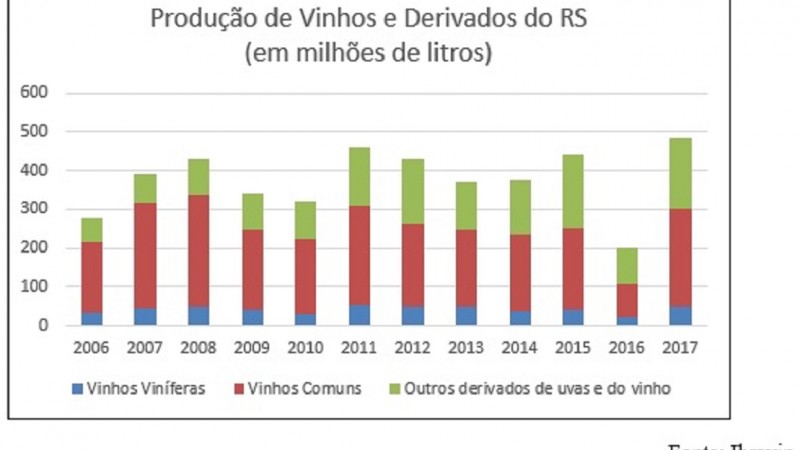 Regarding sales, Rio Grande do Sul’s companies commercialized in 2016 a total volume of 19.2 million liters of fine wines, as follows: 4.1 million liters of white wine, 0.2 million liters of rosé wines and 15 million liters of red wines. Regarding table wines, 165.9 million liters were commercialized in 2016, as follows: 18.7 million liters of white wines, 1.4 million liters of rosé wines and 145.9 million liters of red wines.
Regarding sales, Rio Grande do Sul’s companies commercialized in 2016 a total volume of 19.2 million liters of fine wines, as follows: 4.1 million liters of white wine, 0.2 million liters of rosé wines and 15 million liters of red wines. Regarding table wines, 165.9 million liters were commercialized in 2016, as follows: 18.7 million liters of white wines, 1.4 million liters of rosé wines and 145.9 million liters of red wines.

Sparkling wines
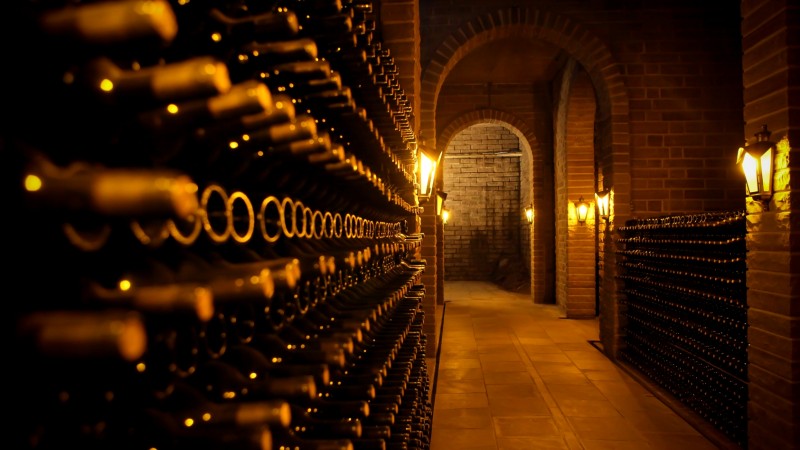 In 2016, 16.9 million liters of sparkling wines produced in Rio Grande do Sul (144% more than in 2006) were commercialized. Of these, 4.5 million liters of sparkling wines made from muscat varieties and 12.4 million liters of other varieties.
In 2016, 16.9 million liters of sparkling wines produced in Rio Grande do Sul (144% more than in 2006) were commercialized. Of these, 4.5 million liters of sparkling wines made from muscat varieties and 12.4 million liters of other varieties.
Other carbonated beverages reached 5.9 million liters sold: 4.2 million liters of filtered sweet wines and 1.7 million liters of sparkling wines.]
The city of Garibaldi, close to Bento Gonçalves, has a national reputation as a producer of sparkling wines.
Source: Ibravin
Agricultural machines and road implements
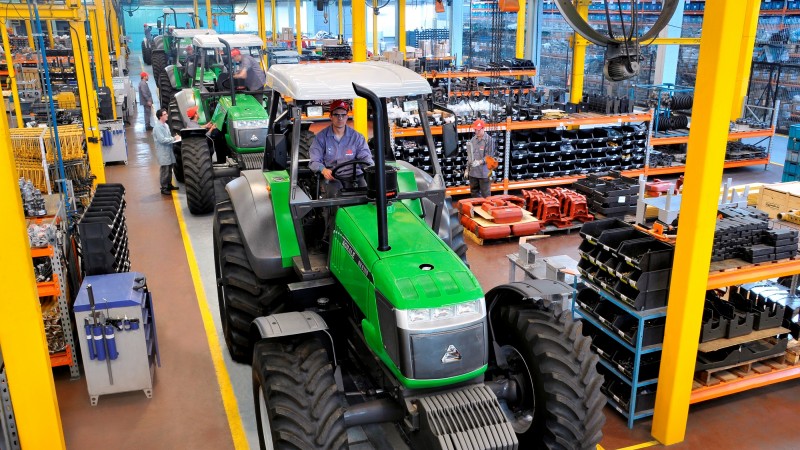 Rio Grande do Sul is Brazil’s largest producer in this segment, accounting for 47.8% of the national production. The state is focused on agricultural machinery: if we exclude road implements from this survey and consider only agricultural machinery, Rio Grande do Sul’s share in Brazil is significantly higher.
Rio Grande do Sul is Brazil’s largest producer in this segment, accounting for 47.8% of the national production. The state is focused on agricultural machinery: if we exclude road implements from this survey and consider only agricultural machinery, Rio Grande do Sul’s share in Brazil is significantly higher.
According to the Association of the Industries of Agricultural Machinery and Equipment of Rio Grande do Sul (SIMERS), more than 65% of the manufacturers of agricultural machinery in Brazil are established in Rio Grande do Sul, with emphasis to companies such as AGCO, Agrale, John Deere, Stara and Mahindra Tratores, among others.
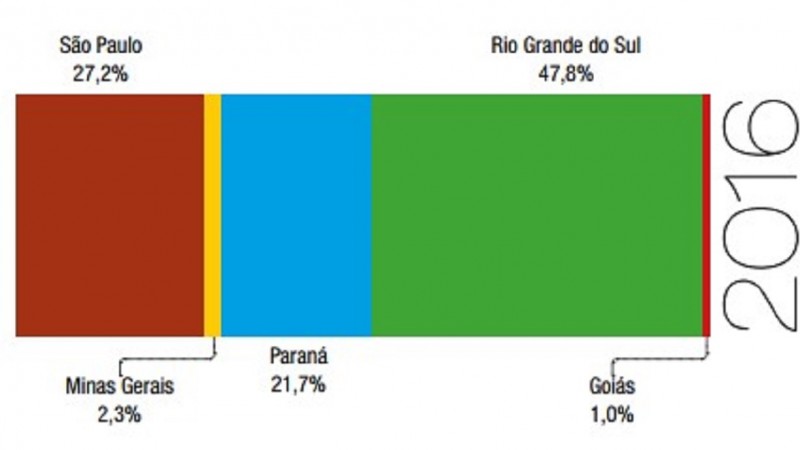 The Pós-colheita cluster, in the cities of Panambi and Condor, specialized in equipment for grain receival, processing and storage is also representative of the sector. The two cities employ around 8,5 thousand employees in 80 companies of different sizes.
The Pós-colheita cluster, in the cities of Panambi and Condor, specialized in equipment for grain receival, processing and storage is also representative of the sector. The two cities employ around 8,5 thousand employees in 80 companies of different sizes.
Research, Development and Innovation (R&D&I)
The State of Rio Grande do Sul has a broad R&D&I network for agribusiness, including universities, research centers, technology parks and incubators. Below, some institutions representative of agribusiness research in Rio Grande do Sul:
- Emater (Technical Assistance and Rural Extension Company)
- Fepagro (State Foundation for Agricultural Research)
- Cientec (Foundation of Science and Technology of Rio Grande do Sul)
- Irga (Rice Institute of Rio Grande do Sul)
- Ibravin (Brazilian Wine Institute)
- Embrapa Uva e Vinho
- Embrapa Trigo
- Embrapa Clima Temperado
- Embrapa Pecuária Sul
- Regional offices of Embrapa (Brazilian Agricultural Research Corporation) in Rio Grande do Sul:
- Capão do Leão (specialized in irrigated rice, seasoned forage, fruits and vegetables)
- Passo Fundo (specialized in oat, rye, barley, rice, beans, corn, soy, triticale, wheat, vines and pineapple)
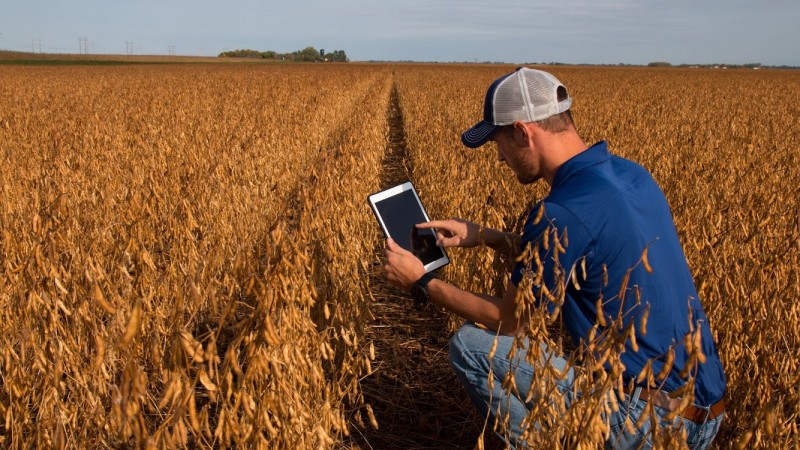 Some of our leading universities and university centers conduct research in agribusiness or related areas. The State also counts on several regional university centers represented by the Consortium of Community Colleges of Rio Grande do Sul (COMUNG), which can be contacted for further details.
Some of our leading universities and university centers conduct research in agribusiness or related areas. The State also counts on several regional university centers represented by the Consortium of Community Colleges of Rio Grande do Sul (COMUNG), which can be contacted for further details.
Opportunities of the Sector in Rio Grande do Sul:
 In general, there is expertise in production, fertile land, and a willingness to assimilate technologies in the industry. However, since the sector is characterized by micro and small companies it lacks capacity of investment in innovation. Investors interested in promoting new productivity and value-adding Technologies have a great opportunity in Rio Grande do Sul.
In general, there is expertise in production, fertile land, and a willingness to assimilate technologies in the industry. However, since the sector is characterized by micro and small companies it lacks capacity of investment in innovation. Investors interested in promoting new productivity and value-adding Technologies have a great opportunity in Rio Grande do Sul.
Business opportunities for partnerships
Look for local opportunities.
